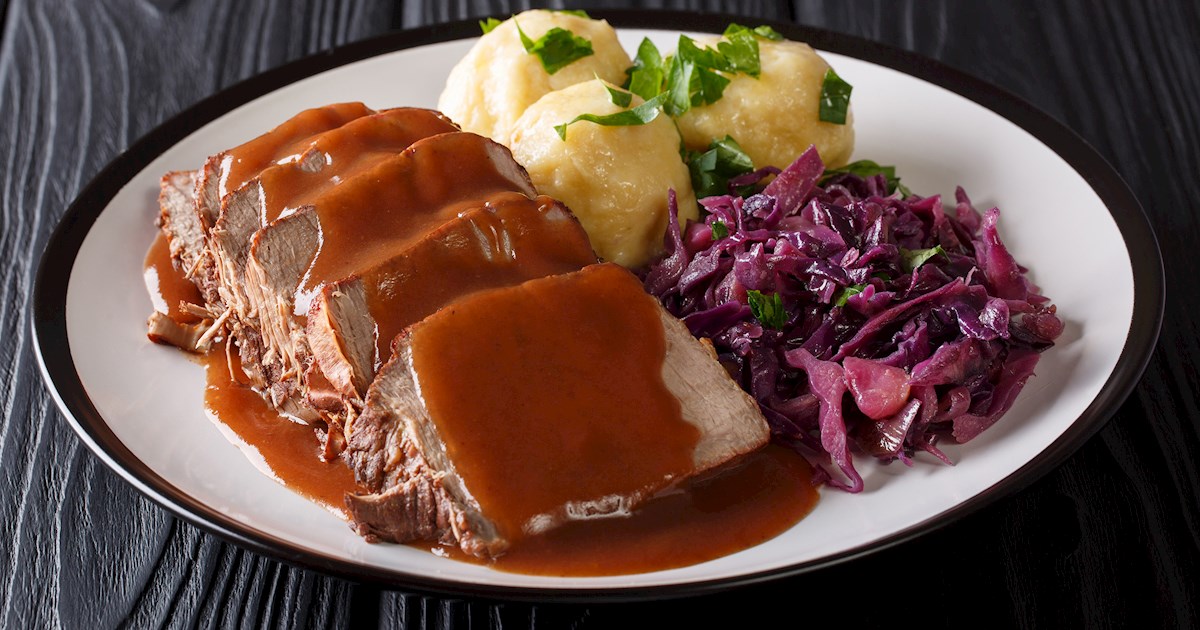vacationhavenhome.com – Sauerbraten, often referred to as “German pot roast,” is a classic dish that epitomizes the comforting, rich flavors of traditional German cuisine. This hearty meal, which has been enjoyed for centuries, is beloved for its tender meat, aromatic spices, and its deliciously tangy sauce. If you’re seeking a dish that combines history, flavor, and a sense of nostalgia, Sauerbraten is an ideal choice.
What Is Sauerbraten?
At its core, Sauerbraten is a marinated beef roast, slow-cooked to tender perfection. The meat is typically marinated for several days before it’s cooked, ensuring that it’s infused with a depth of flavors that are both savory and slightly sour. The marinade usually consists of vinegar, water, onions, and an array of spices like cloves, bay leaves, and peppercorns, giving it a distinctively tangy, aromatic profile.
Sauerbraten isn’t just about the meat; it’s about the sauce. The marinade is simmered down after the roast is cooked, creating a rich gravy-like sauce that’s perfect for spooning over the tender beef and accompanying side dishes.
While beef is the most common meat used for Sauerbraten, other variations exist, where pork, lamb, or even traditionally, game meat like venison, can be used. These variants are popular depending on the region in Germany, but the most well-known and widely loved version is made with beef.
A Historical Dish
The origins of Sauerbraten trace back to the Middle Ages. The concept of marinating meat in vinegar and spices was a method used to preserve meat, particularly in the days before refrigeration. This practice helped tenderize the meat, making it easier to digest, and also gave the dish a characteristic sourness that has come to define Sauerbraten.
The dish is often associated with the German region of Franconia and the Rhineland, though it’s popular throughout Germany today. As you travel across the country, you’ll find different regional takes on the dish, each offering unique twists on the marinade, spices, and accompaniments.
How Is Sauerbraten Made?
Ingredients:
- 2-3 lb (1-1.5 kg) beef roast (often rump or chuck)
- 2 cups red wine vinegar or white wine vinegar
- 1 large onion, sliced
- 2-3 cloves garlic, crushed
- 2 cups beef stock or water
- 2 tbsp sugar
- 1 tbsp salt
- 1 tbsp whole black peppercorns
- 2-3 bay leaves
- 5-6 whole cloves
- 1 tbsp mustard seeds (optional)
- 2 tbsp vegetable oil for browning
For the gravy:
- 2 tbsp flour
- 2 tbsp butter
- 1-2 cups of the marinade or beef stock
Instructions:
- Marinate the Beef: In a large bowl, combine the vinegar, beef stock, onions, garlic, sugar, salt, peppercorns, bay leaves, cloves, and mustard seeds. Add the beef roast to the marinade, ensuring it is completely submerged. Cover and refrigerate for 3-4 days, turning the meat every day to ensure even marination.
- Browning the Meat: After the marination period, remove the roast from the marinade (reserve the liquid for the next steps). Pat the beef dry with paper towels, then heat vegetable oil in a large pot or Dutch oven over medium-high heat. Brown the roast on all sides until a deep, golden color develops.
- Simmering the Roast: Once the meat is browned, add the reserved marinade to the pot with the beef, making sure the liquid covers the meat. Bring the liquid to a boil, then reduce the heat to a simmer. Cover the pot and let the roast cook for 2.5 to 3 hours, or until the beef is tender and can be easily shredded with a fork.
- Making the Gravy: Once the roast is done, remove it from the pot and set it aside to rest. Strain the marinade to remove the spices and vegetables. In a separate pan, melt the butter and whisk in the flour to form a roux. Gradually add the strained marinade (or beef stock) to the roux, stirring continuously until a smooth, thick gravy forms. Season the gravy with salt and pepper to taste.
- Serving: Slice the Sauerbraten into thick slices and serve with the rich gravy. Traditional sides include potato dumplings, boiled potatoes, or mashed potatoes, as well as a side of red cabbage or sauerkraut for a well-rounded, flavorful meal.
Why Sauerbraten Is So Special
Sauerbraten is more than just a meal—it’s a celebration of the craft of slow-cooked, marinated dishes. The long marination time ensures that the beef absorbs all the aromatic flavors, creating a depth of taste that is complex yet comforting. The combination of sour and savory elements in the dish also brings a certain balance, making it uniquely satisfying.
This dish represents German culinary tradition in its simplest yet most powerful form. It’s the kind of dish that calls for a cozy family dinner, a holiday gathering, or even a comforting weeknight meal. In Germany, Sauerbraten is often served for festive occasions like Easter or Christmas, making it a dish that brings people together.
Regional Variations
Although the general concept of Sauerbraten remains consistent across Germany, there are regional variations based on local ingredients and preferences:
- Rhenish Sauerbraten: This version, originating from the Rhineland, is often made with a sweeter marinade, incorporating ingredients like raisins or wine.
- Franconian Sauerbraten: Hailing from the Franconia region, this variation often uses a combination of vinegar and beer, adding a richer, more robust flavor to the sauce.
- Sauerbraten with Potato Dumplings: While the dish is frequently served with potatoes, many regions in Germany pair it with the iconic potato dumplings (Kartoffelknödel), which soak up the savory gravy.
Pairing Sauerbraten
Sauerbraten pairs wonderfully with German-style beers such as a crisp pilsner or a malty bock. A glass of full-bodied red wine, such as a Riesling or Pinot Noir, also complements the tangy notes of the dish. For sides, classic German accompaniments like sauerkraut, pickled red cabbage, or roasted vegetables elevate the meal and provide a balance to the richness of the meat.
In Conclusion
Sauerbraten is a time-honored German dish that speaks to the heart of traditional home cooking. Its comforting, flavorful nature makes it a favorite in households across Germany and beyond. Whether enjoyed at a festive dinner or as a casual Sunday roast, Sauerbraten offers a taste of history, culture, and warmth with every bite. So, next time you’re craving a dish that’s both satisfying and full of rich flavor, give Sauerbraten a try—you won’t be disappointed.





